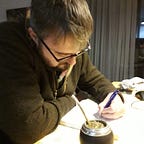Yerba Maté from Argentina to Syria
Yerba Maté is a beverage of the Guarani tribe in Paraguay, Argentina, Brazil and Uruguay. Currently it is produced in the North-East of Argentina for the Syrian Market from the leaves of Ilex paraguariensis. The main co-operative and authentic producer is ‘Taragui’. In Syria it comes like ‘Yerba’, made in Argentina. You can drink this is ‘Lagrange Points’ cultural center in Brussels, because Syria is the main importer of Argentinian Maté, before the revolution around 70% of the Argentinian maté export went to Syria.
In the cultural center ‘Langrange Points’ you can drink Maté in a small glass, with an iron straw. Where in Argentina it is a collective drink, you give it around in a circle, in the Middle Eastern World it is more hygienic, because people drink it alone.
There are other differences and these are that Syrian maté is taken in a glass, in Latin-America they use a pumpin-like ‘calabas’. The pumkin is dried and the Guarani used to keep there foodsupllies inside the ‘Calabas’, but also there Yerba Maté. The Argentinians use sugar sometimes in addition, because it is too bitter, but this is mostly for kids. The Syrians even add cinnamon, ginger, sage, cardamon. In Summer days Argentinians put lemonade in powder and in Syria cold water with ice cubes.
The raison why Yerba Maté is introduced in Syria has to do with the migration from the late Ottoman Empire to Latin America. A lot of communities in the Middle East came under pressure, because of the suez-canal, which interrupted the ‘Silk Roads’, because of the war in Mount Lebanon, which created overpopulation afterwards, and also at the end of the ‘Tanzimaat’, Istanbul started to recrute young people in the Empire and they also started to collect taxes.
This implied that the self-sustainable agriculture in the Ottoman Empire became under pressure. So the sons of the peasants flet first to the border regions of the Ottoman Empire and then went to the Mediterranian ports like Marseilles to go without an invitation to Latin America.
They would open shops and would work as ambulant street vendors of cloths and tissues all over Latin-America. The communities have been everywhere were there are people bargaining in the Americas.
The communities who strech from Mexico to Chile would organize themselfs for example with cultural centers. The reason is mostly that with the end of slave labour in the Americas, these countries seeked cheap labour forces and each foreign community had it’s price.
With the great depression in ’28 the Ottoman communities got underpressure, a lot lost their jobs and the poor decided to go back to the Ottoman Empire which had become a French protectorate, even the consulates were french for the Ottomans in Latin America. The Argentinian Ottoman community returned with them Yerba Maté and Latin American wifes, but the great exodus of people in the late Ottoman Empire made that their countries were in ruins.
According to the new book (Argentina and the Global Middle East, June 2020) of Assistent Professor Lilly Balloffet at the Research Center for the Americas UC Santa Cruz, there was also a big re-immigration in the sixties. So there were always active bounds between Latin America and the Middle East in the twentieth century.
Syrian Maté can be tried in Lagrange Points Brussels cultural center, Huidevettersstraat 114, 1000 Brussels. (Neighbourhood Marollen, close to ‘jeux de Balles’)
